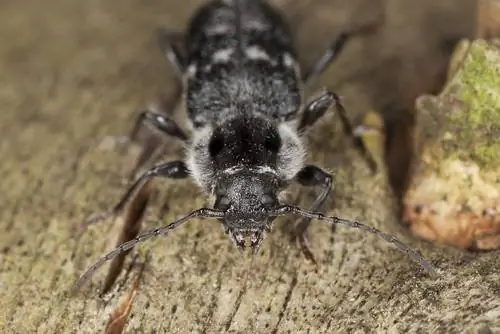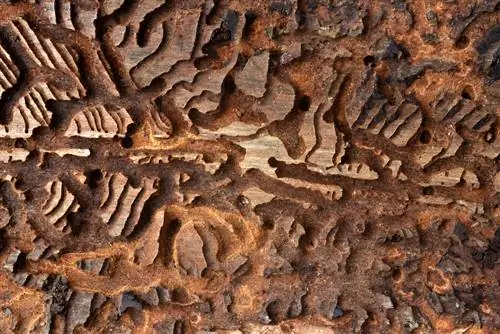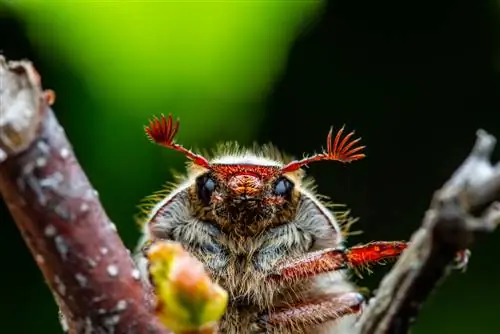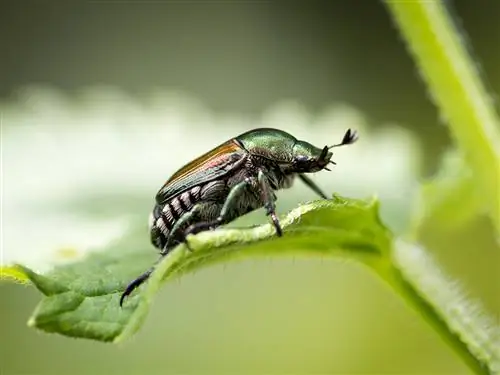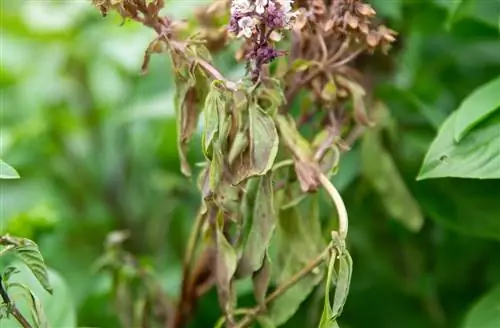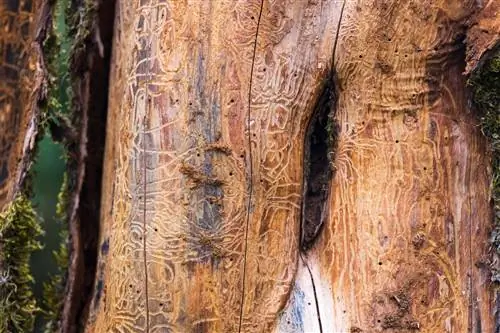- Author admin [email protected].
- Public 2023-12-16 16:46.
- Last modified 2025-06-01 06:02.
Timber longhorn beetles are among the most dangerous pests that attack wood. However, an infestation is often only discovered when the damage is well advanced. Early detection is not hopeless, because the larvae reveal themselves through certain damage patterns.
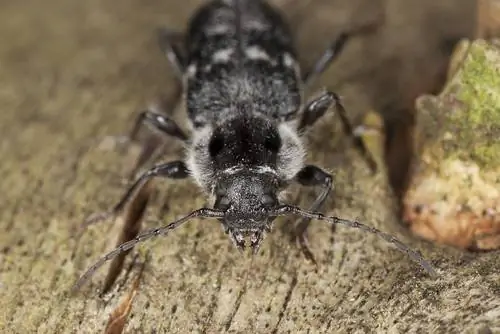
How do you recognize and combat a longhorned beetle infestation?
The longhorned beetle is a dangerous pest that can attack coniferous wood and cause serious damage. Signs of an infestation include oval holes in the wood, feeding noises and thin wood skin that can be easily scratched off. Early control is recommended by heat treatment or - for smaller objects - by heating in the oven or freezing.
Detecting infestation through malicious images
Timber longhorn beetles are able to severely damage built-up wood from conifers in a very short period of time. In Germany, the house goat is considered the most dangerous wood destroyer in the house, which is why in some federal states a reporting requirement has been set in the building regulations. If you notice an infestation, you should contact the responsible building authority immediately.
Tip
When building your house, choose wood with a minimum heartwood content of 90 percent. This is not affected by house beetle or woodworm.
Signs of an infestation
The feeding activity of the longhorned beetles is much more difficult to detect than damage caused by the woodworm (Anobium punctatum). The house beetle clogs wood passages with sawdust and droppings so that no tell-tale piles of wood dust are left behind. These corridors will not be entered again.
If there is a severe infestation, a thin wooden skin remains that can be easily scraped off and reveals the passage system. The only external identifying feature on infested wood are the oval exit holes of the adult beetles. These are between four and seven millimeters in size. Feeding noises are a clear indication of an active infestation.
Excursus
Tracking down the house buck with search dogs
Since 2008, experiments have been carried out in Australia with detection dogs, which are intended to detect an infestation by the domestic goat at an early stage. For this purpose, two Labrador dogs were initially specifically trained. Their keen sense of smell is said to make it possible to detect the beetle larvae in the wood up to three years earlier. Conventional measures by searching built-up wood only provide reliable information if there are already escape holes for adult beetles. Then they may have already reproduced and laid new eggs.
Assessing an infestation
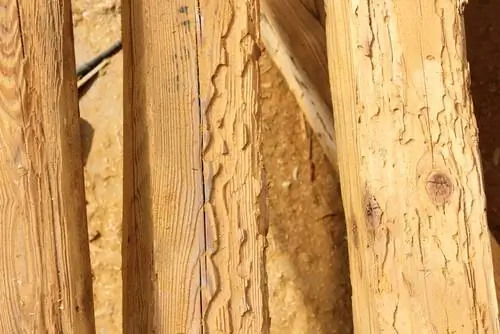
A woodbuck infestation is often only discovered very late
Before countermeasures are initiated, the infestation must be checked and ensured by a specialist. The house beetle is not always a possible pest for eating marks in the wood. Other insects also leave tunnels in roof beams.
Wood age and endangerment
During an infestation inspection, the intensity of the infestation and the age of the wood on the undamaged beams are checked. Statistically speaking, it is very unlikely that timber that is around 60 years old will be affected. This means that wood protection applied later has no benefit.
The attractiveness of the wood species is very strong in the first 30 years and then steadily decreases. Wood is hardly at risk after 100 years and 140-year-old timber is only affected in rare exceptions. However, infestation cannot be completely ruled out, even with old wood. If the males only find impregnated wood, they also place their scent marks on untypical old wood. In addition, fresh repair wood can increase the attractiveness again.
The older the wood, the less likely an infestation is. However, this is not completely ruled out.
Beware of dubious experts
It is not uncommon for companies to take advantage of citizens' ignorance and carry out nonsensical or overpriced countermeasures. So-called door-to-door transactions often occur, in which residents allow themselves to be taken by surprise by self-proclaimed experts and sign contracts out of concern.
In some cases, the infestation is so severe that the control methods advertised are no longer effective and the entire roof structure has to be replaced. Many measures are also pointless if the infestation has already gone away or is only very weakly developed. More rarely, expensive control measures are offered, even if wood damage was caused by other harmless insects such as the wood wasp or the disc beetle.
Combat
In the event of a positive control, different measures are taken depending on the intensity. The pests are often controlled with chemical agents. Contact insecticides are not always the best solution as they make pests difficult to reach. Effective combating takes place using the hot air process using high temperatures. Smaller items can be heated in the sauna. In a microwave with a built-in horn emitter, the wood can be irradiated and overheated for several minutes, killing all living creatures that contain water.
Chemical control:
- Peeling and impregnating wooden surfaces
- pressure or pressureless injection
- Fumigation with sulfuryl fluoride
Tip
To kill all life in the wood, you should heat the piece of furniture to 65 degrees Celsius for one to three hours. Proteins in the body begin to coagulate at around 60 degrees Celsius, causing the organism to die.
Profile
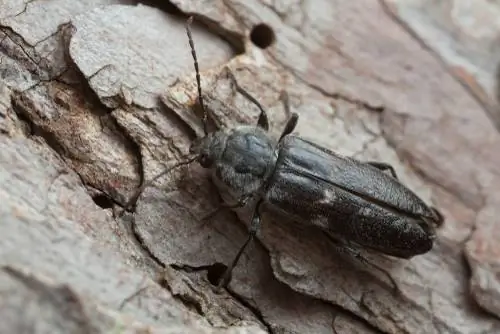
The longhorned beetle is not very conspicuous
The longhorn beetle, which is incorrectly called the longhorn beetle for short, belongs to the longhorn beetle family. As such, the beetle can be recognized by its long antennae, which are slightly curved backwards. Because of this typical feature, the family was given the German common name. The species behind the longhorned beetle is Hylotrupes bajulus. Loosely translated, this species name roughly means “one that drills into the wood of the wearer”. This expression indicates the beetle's way of life.
A beetle with many names:
- Beam trestle
- Hausbock
- Big Woodworm
Typical characteristics
Adult beetles are between eight and 26 millimeters long. The body is comparatively flat. Color and markings may vary between individuals. The basic color is brown to black, although the legs and antennae usually appear a little lighter. The entire body is covered with fine, grayish-shimmering hairs. In some animals the elytra clearly show two pairs of white hair spots. These can be more or less intensively developed.
Physique
Timber longhorn beetles have a strongly rounded pronotum, on the top of which two shiny calluses can be seen. The pronotum is significantly wider than the head. The thickened shanks of the legs, whose claws have small teeth, are striking. For a longhorn beetle, the house longhorn beetle has comparatively short antennae, with the third antenna segment being longer than the fourth.
Larva
House longhorn beetle larvae can reach a length of up to 30 millimeters. Its ivory-colored body is clearly articulated and ends in a larger head that has powerful mouthparts. Next to the eating tools there are three point eyes. If they are not disturbed, their noises, which are made by scraping the wood fibers, are clearly audible. They can be used as a sure sign of wood infestation. At the slightest disturbance they stop eating and fall silent.
Lifestyle and development
Between May and August, the beetles are looking for a partner, although they only live for around four weeks. During this time the house buck does not eat any food. Since it is a dry wood insect, the beetles only lay their eggs in dry and mostly built-up wood.
Wood Search
Immediately after hatching, the females start looking for a suitable place to lay their eggs. It uses the escaping aerosols to assess the suitability of different types of wood. Males also look for a suitable and protected area in the wood that is suitable for mating. They then produce a sexual attractant to attract a female willing to mate. However, these are also influenced by the scent intensity of the woods. In this way, the females try to find the wood that offers optimal development opportunities for their offspring.
Mating
The female lays eggs two to three days after mating. These are placed in small cracks in the wood through a flexible laying tube. Even the smallest gaps with a width of 0.3 millimeters are sufficient.
When one egg is laid, six to eight clutches are created, each containing an average of 50 to 60 eggs. In total, females can lay between 140 and 200 eggs. Individual females produce more than 500 eggs. Males die shortly after mating, while females die after laying their eggs.
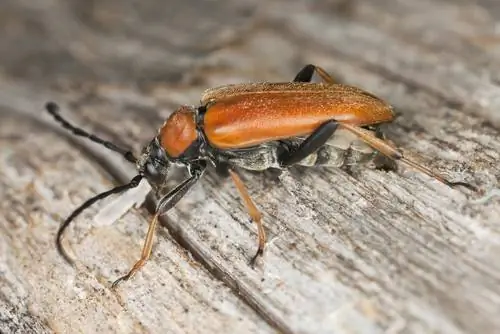
A single female lays between 50 and 60 eggs
Development cycles
The larvae eat deeper into the wood shortly after hatching. They go through several growth cycles between which they molt, with the duration of larval development being influenced by various factors.
After the last larval stage, pupation occurs just below the surface of the wood. The larva undergoes metamorphosis and emerges as a sexually mature beetle. It usually takes four to six years for the larva to develop into an adult beetle. If the larvae live in nutrient-poor wood, development can extend to twelve and, in rare cases, 18 years.
This influences larval development:
- Nutrients: high protein content important
- Moisture: ideally between twelve and 30 percent
- Temperature: Optimum between 28 and 30 degrees Celsius
- Type of wood: prefers softwood such as fir, pine or spruce
Types of longhorn beetles
The European longhorned beetle is easy to recognize and difficult to confuse with other species. The biggest misunderstandings arise from misleading names for different species. The incorrect name common longhorned beetle occasionally occurs. This name probably came about as a mixture of the common wood tick species and the common longhorn beetle from the longhorn beetle family. There are a number of other longhorned beetles that act as pests.
| scientific name | other names | Damage | Recognize | |
|---|---|---|---|---|
| Asian longhorned beetle | Anoplophora glabripennis | Asian longhorned beetle | Deciduous and fruit trees | black with light spots |
| Chinese longhorned beetle | Anoplophora chinensis | Citrus Longhorn Beetle | Deciduous trees, preferably citrus plants | black with light spots |
| Common Longhorn Beetle | Stictoleptura rubra | Red Neck Goat | Coniferous wood, preferably spruce and pine | bright reddish brown |
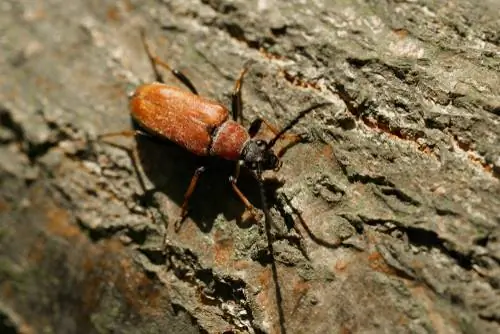
The red-necked ram doesn't just have a red neck
Food
Timber longhorn beetles only attack softwoods such as pine and spruce, fir and larch or Douglas fir. Hardwoods secrete substances that kill the larvae. These feed mainly on the sapwood, which is located in the outer areas. Occasionally they go on exploratory tours to the inner heartwood. However, this is largely avoided. The reason for this behavior is the nutrient content of the wood. The nutrient content in the outer annual rings is significantly higher than in the heartwood. The lower the protein content, the slower the larvae develop.
Occurrences
The distribution area of the longhorned beetle extends across the entire Palearctic. The wood pest was introduced by humans to North America, South Africa and Australia. Females only lay their eggs in dead conifers so that their larvae can benefit from the nutrient-rich sapwood. The beetles often occur in the built-up wood of roof trusses or wooden facades, as there are optimal conditions for development here. Often there are already eggs in the firewood or firewood, so the pests can easily be introduced.
Frequently asked questions
What does the house goat look like?
The wood pest, which belongs to the longhorned beetle, has a variable body that can be more than two centimeters long. Its antennae are relatively short and curved backwards. The beetle is brown to black in color and hairy. White patches of hair can sometimes be seen on the wings. The thickened thighs are another identifying feature.
Can you confuse the longhorned beetle?
It is almost impossible to mix up the adult beetles, as all other longhorn beetles look different. The ash-gray evening buck (Trichoferus holosericeus, synonym: Hesperophanes cinereus) is sometimes referred to as a wood buck lookalike. This species was introduced from warm climates and only inhabits deciduous trees. Adult beetles can be identified by their coloring. This doppelganger has a reddish-brown basic color, which is however hidden by the intense gray to whitish hair. As a dry wood insect, this species also causes damage to the wood.
How do I recognize an infestation by the longhorned beetle?
An infestation often goes unnoticed until the first exit holes on the wood become visible. Then the larva may have already caused major damage. The first sign of an infestation is feeding noises coming from the beams. They are reminiscent of the scratching and scraping that occurs when the edges of the thumb and middle fingernails rub together. In some cases, bulges can be seen on the wooden surface.
You should pay attention to this:
- paper-thin layer of wood can be easily scraped off
- Corridors filled with dusty sawdust appear
- typical corrugations on the corridor walls
Why do the sounds of the house longhorn larvae fall silent when disturbed?
The larvae are extremely sensitive to noise, as one of its natural enemies is the woodpecker. It looks for food by knocking on the wood and looking for insects and larvae. House longhorn larvae fall silent at the slightest disturbance so that no predators become aware of them.
How can I prevent a house buck infestation?
Choose native types of wood that are resistant to infestation by the longhorned beetle. Heartwood from larch, pine and Douglas fir, which has a maximum proportion of ten percent sapwood, ensures optimal prevention. Likewise, dry, crack-free wood protects against infestation. If you cannot do without spruce or softwood lumber rich in sapwood for cost reasons, you should treat it with a chemical wood protectant before installation.
How to protect wood:
- Avoid heat-storing wooden formwork
- Wooden structures must be well ventilated
- do not wall up wood to avoid moisture accumulation
- don't dry laundry in the attic
- Close attic hatches during flight time

